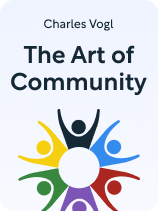

This article is an excerpt from the Shortform book guide to "The Art of Community" by Charles Vogl. Shortform has the world's best summaries and analyses of books you should be reading.
Like this article? Sign up for a free trial here.
Why are community traditions and customs important? What’s the process of introducing a custom to people?
According to Charles Vogl, communities must institute formal and informal customs that mark meaningful moments. Common customs include celebrations of progress, fun traditions, cultural demonstrations, and moments of silence.
Discover more about creating traditions that people will practice for generations.
Instituting Meaningful Customs
Community traditions can happen in physical or online communities—for example, an online craft community might hold a weekly “show off some work you’re proud of” activity.
(Shortform note: Customs have the power to draw communities together no matter the circumstances, and they become especially important when a community is threatened by dissolution or some other hardship. For example, many Native American communities responded to the threat of assimilation and extirpation in the late 1800s by instituting the Ghost Dance tradition—a custom intended to restore Native American traditions and culture. Similarly, one way that immigrants resist total assimilation and stay connected to their communities of origin is by holding regular celebrations of their heritage, where they eat traditional food, play traditional music, and wear traditional clothing.)
Vogl explains that customs become meaningful when they’re repeated because repetition connects past, present, and future generations of the community. However, customs can change over time to suit newer generations’ needs—for example, family reunions might replace board games with video games. Nevertheless, customs usually follow a pattern (for instance, your community of coworkers might start each meeting by shouting out each other’s strengths and achievements before moving on to business matters).
(Shortform note: The rigidity or flexibility of a community’s customs can be a controversial topic within the community. Some people are traditionalists—they believe it’s important to honor the same customs in the same ways, no matter what changes have occurred since the community’s inception. Others, called modernists, are more open to change and willing to adapt their customs by replacing outdated elements with novel ones. According to anthropologists, community customs are most likely to change when new technologies are developed and shown to enhance life. For example, the Amish have a custom of farming without the use of manmade machinery, but some communities have embraced new farming technology.)
Vogl recommends the following pattern as a basis for formal customs:
First, introduce the custom. This involves greeting participants, stating the purpose of the custom, reminding participants of previous times they practiced a custom (to help drive home meaningfulness), and giving an overview of what’s going to happen next so that each participant knows what to expect and understands any rules they have to follow.
Second, engage in the custom. Vogl recommends incorporating a few meaningful words at the start of the custom. For example, funerals often begin with a piece of scripture that provides comfort to mourners. Then, ask participants to engage in a group activity if they’re willing. Vogl notes that it’s better for the activity to have metaphorical meaning, rather than literal meaning, because this enables participants to come to their own personally meaningful conclusions about the activity’s significance.
Finally, conclude the custom by making a statement about what you’ve achieved with this custom and releasing participants from the custom or meeting place. Vogl explains that formally releasing participants helps them reorient themselves: They were doing something special, and now they’re returning to the more mundane parts of their lives.
| Other Best Practices for Community Customs From The Art of Gathering In The Art of Gathering, Parker shares some best practices for hosting group events. Applying these to your community’s customs can help members make the most of their time together. First, let’s discuss Parker’s recommendations for opening community events (including customs) effectively. Before the event begins, she says you should provide a literal or psychological transition, like a physical doorway or an activity that grabs guests’ attention. That way, members can forget about other parts of their lives and focus on the event at hand. Then, she says you should open the event by intentionally welcoming guests (perhaps by greeting them, as Vogl suggests) and creating a community atmosphere (for example, by having guests introduce themselves to each other before the custom begins). Parker also shares some recommendations that leaders can use during the custom itself. First, she says that in some cases, the meaningful words you share at the start of your custom should take the form of vulnerable storytelling. She explains that when event attendees share stories about themselves, they form more authentic connections with each other; this would imbue your custom with a greater sense of meaning. Parker also suggests that as the host of a community event, you should help attendees get to know each other better—for example, during the group activity Vogl suggests incorporating, you could pair members of the community who don’t know each other very well. Parker also says you should consider inviting people who don’t know each other at all—but acknowledges that may be tough to do unless your community is very large or you’re bringing two subcommunities together. If a situation like this does arise, it’ll be even more important for the event’s host to forge connections between members who are strangers to each other. Parker agrees with Vogl that it’s important to reorient participants to the outside world at the end of your custom. To that end, she suggests following these steps: First, when the custom has been fulfilled and enthusiasm is still high, let attendees know that the event will be ending soon. That way, the event will end on a high note instead of petering out on its own. Next, deal with any housekeeping issues (for example, determining a time and place for your next custom). Then unite the community once more, perhaps by asking them to reflect on their time together. Finally, help participants transition to mundane life; you can do this by giving them a memento and officially ending the event. |

———End of Preview———
Like what you just read? Read the rest of the world's best book summary and analysis of Charles Vogl's "The Art of Community" at Shortform.
Here's what you'll find in our full The Art of Community summary:
- The fundamental guidelines all communities should follow
- How to institute a community meeting place and set of customs
- How you can enhance belonging within your community






